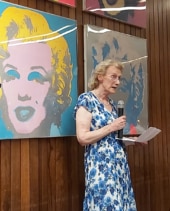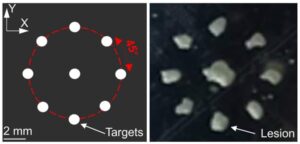Isabel Rabey reviews Not Just For the Boys: Why We Need More Women in Science by Athene Donald

Despite years of campaigning, women are still wildly under-represented in science. According to UNESCO, only one third of scientific researchers are female. In physics, the imbalance is even starker, with women making up under a quarter of undergraduate physicists in the UK and only 10% of physics professors. At every step in their careers, we see fewer and fewer women represented: of all the Nobel-prize winners in science, just 4% are female.
So how did we get into this terrible situation and why are so many women being forced out of science? Those are among the questions tackled in Not Just For The Boys: Why We Need More Women in Science by Athene Donald, who has spent more than 50 years in physics and is currently master of Churchill College, Cambridge. This book is her personal manifesto, in which she sets out her vision for the future of science, technology, engineering and mathematics (STEM). Most importantly, as a successful physicist in her own right, she outlines what everyone can do to shape the future.
The book begins by striding through the experiences and views of some of the most famous female scientists from the past four centuries. These range from Margaret Cavendish, Caroline Herschel and Mary Sommerville to Nobel-prize-winners like Christiane Nüsslein-Volhard, May Britt-Moser and Donna Strickland. Those early pioneers fought against significant barriers in pursuit of their passion, but Donald cleverly chooses to highlight events in those scientists’ lives that echo the experiences of women today.
For example, she mentions how female scientists get comments on their appearance while their scientific contributions are dismissed. She notes how women are sometimes paid less than men in the same position and how some female scientists need to conceal their learning to fit into society’s idea of “femininity”. Despite the significant progress we have made since the 17th century, the invisible barriers that women face are as insidious as ever.
Athene Donald describes the key issues confronting women today and how they are put off – and pushed out of – science at every stage of their lives
Donald then describes the key issues confronting women today and how they are put off – and pushed out of – science at every stage of their lives. From the influence of toys, parents and teachers during childhood, to the bias in citations, reference letters and funding allocations as a professional scientist, Donald covers it all. Many will find the breadth of this book informative and thorough, particularly for those not familiar with the topic; parents, teachers, politicians and male scientists are the target audience here.

The best part of this book is how Donald weaves her own experiences through many of the issues she discusses. With the help of quotes from other top research scientists, her personal anecdotes humanize the real-life consequences of bias, which can hit even those who have reached the top of their field.
In one notable story, Donald recounts how she was harassed at a conference by a senior male scientist. He equated her studies of the microscopic structure of starch (for which she is now renowned) with domestic science, belittling the serious physics she was studying, and implying that this “mere cookery” was the only thing she was capable of as a woman. Despite this disturbing incident occurring more than 25 years ago, Donald still remembers how it made her feel at the time.
This story is a perfect example of how incidents of sexism and misogyny can create ripples through peoples’ lives that are still felt decades later. But what also comes across throughout the book is Donald’s love of science. She talks with enthusiasm about how fun and exhilarating scientific research can be, something that shines through in the stories from her early career.
This passion has clearly fuelled Donald’s lifelong campaign for gender equality in STEM. Not only is science losing potential scientists, but women are also missing out on inspiring and exhilarating careers. Anyone can be a scientist, Donald argues. They just need curiosity, creativity, resilience and a little bit of luck. As it stands, however, women need more resilience than men to break through the barriers they face.
A theme that runs throughout the book is the importance of male allies and supporters
A theme that runs throughout the book is the importance of male allies and supporters. Returning to the harassment she experienced at that conference all those years ago, Donald describes how much of a difference it made to have a male friend witness the event. Afterwards, he was able to reaffirm the fact that Donald had done nothing to warrant this attack and that she should not feel any guilt or blame for what happened.
This particular male colleague went on to support her in making a complaint to the conference organizers, which ultimately caused the senior scientist to be barred from attending that particular event ever again. Donald also talks personally about how important it was for her husband – a research mathematician – to take a step back from his career to allow hers to flourish after they had children.

Athene Donald: why even great physicists like her suffer from impostor syndrome
Donald’s vision for the future of STEM is simple: mediocre women should be able to enjoy the same success rates as mediocre men. The trouble is that when women have multiple negative experiences in science, they can end up deciding to leave the profession. Even though those experiences individually might seem insignificant, it all just gets tiring when you face them again and again. Small acts of support and allyship can, however, create major change.
We’re not talking huge self-sacrifice. It could just be physicists standing up against inappropriate behaviour. It could be nominating women for prizes. Or it could be refusing to serve on single-sex panels or conferences without an appropriate number of women invited speakers. All such actions can play a part in creating change. In fact, if you want to help build a future where women scientists can simply be scientists, but still aren’t sure what you can do, reading this book is a good place to start.
- 2023 Oxford University Press 288pp £16.99hb
- SEO Powered Content & PR Distribution. Get Amplified Today.
- PlatoData.Network Vertical Generative Ai. Empower Yourself. Access Here.
- PlatoAiStream. Web3 Intelligence. Knowledge Amplified. Access Here.
- PlatoESG. Automotive / EVs, Carbon, CleanTech, Energy, Environment, Solar, Waste Management. Access Here.
- BlockOffsets. Modernizing Environmental Offset Ownership. Access Here.
- Source: https://physicsworld.com/a/attention-all-allies-why-there-are-so-few-women-in-science-and-how-you-can-help/
- :has
- :is
- :not
- :where
- $UP
- 160
- 2022
- 25
- 50
- 50 Years
- 7
- a
- Able
- About
- AC
- across
- actions
- acts
- After
- afterwards
- again
- against
- ago
- All
- allocations
- allow
- also
- among
- an
- and
- any
- anyone
- appropriate
- ARE
- Argues
- AS
- At
- attack
- attending
- attention
- audience
- back
- barriers
- BE
- being
- BEST
- bias
- Bit
- book
- breadth
- Break
- build
- but
- by
- cambridge
- Campaign
- campaigning
- CAN
- capable
- Career
- careers
- cartoon
- caused
- centuries
- Century
- change
- Children
- clearly
- click
- colleague
- College
- comes
- comments
- complaint
- conceal
- Conference
- conferences
- Consequences
- contributions
- could
- Covers
- create
- Creating
- creativity
- curiosity
- Currently
- decades
- Deciding
- Despite
- DID
- difference
- do
- Domestic
- donald
- done
- during
- Early
- echo
- end
- Engineering
- enjoy
- enthusiasm
- equality
- Even
- Event
- events
- EVER
- Every
- everyone
- example
- exhilarating
- experienced
- Experiences
- Face
- fact
- familiar
- famous
- feel
- female
- few
- fewer
- field
- Find
- fit
- flourish
- For
- four
- friend
- from
- front
- fun
- funding
- future
- Gender
- Gender Equality
- get
- good
- great
- had
- happened
- Have
- he
- heads
- help
- her
- here
- Highlight
- his
- Hit
- How
- However
- HTTPS
- huge
- icons
- idea
- ideas
- if
- image
- imbalance
- importance
- important
- in
- incident
- Individually
- influence
- information
- informative
- inspiring
- into
- invited
- issue
- issues
- IT
- jpg
- just
- Key
- later
- learning
- Leave
- less
- like
- little
- Lives
- losing
- love
- luck
- made
- major
- Making
- many
- mark
- master
- mathematics
- max-width
- Men
- mentions
- microphone
- might
- missing
- more
- most
- much
- multiple
- Need
- negative
- notable
- Notes
- nothing
- now
- number
- occurring
- of
- off
- on
- ONE
- only
- open
- or
- organizers
- Other
- out
- outlines
- own
- Oxford
- oxford university
- paid
- panels
- parents
- part
- particular
- particularly
- passion
- past
- perfect
- personal
- Personally
- photo
- Physics
- Physics World
- pioneers
- Place
- plato
- Plato Data Intelligence
- PlatoData
- Play
- Politicians
- position
- potential
- press
- prizes
- profession
- professional
- Progress
- pursuit
- pushed
- put
- Questions
- quotes
- range
- Rates
- reached
- Reading
- refusing
- represented
- representing
- research
- researchers
- resilience
- retirement
- returning
- Reviews
- right
- ripples
- runs
- s
- same
- Science
- scientific
- Scientist
- scientists
- see
- seem
- senior
- September
- serious
- serve
- Sets
- Shape
- she
- should
- significant
- Simple
- simply
- since
- situation
- small
- So
- some
- something
- speakers
- speaking
- spent
- Stage
- stands
- start
- Stem
- Step
- Still
- Stories
- Story
- structure
- studies
- Studying
- success
- successful
- such
- support
- supporters
- sure
- surrounded
- Take
- talking
- Talks
- Target
- teachers
- Technology
- than
- that
- The
- The Future
- the UK
- their
- Them
- theme
- then
- There.
- These
- they
- thing
- Third
- this
- those
- though?
- Through
- throughout
- thumbnail
- time
- to
- today
- top
- topic
- trouble
- true
- Uk
- Ultimately
- university
- views
- vision
- want
- Warrant
- was
- we
- went
- What
- when
- which
- while
- WHO
- why
- Wikipedia
- will
- winners
- with
- without
- witness
- woman
- Women
- wood
- world
- years
- You
- zephyrnet













